Top 6 Shipping Container Sizes for Homes & Which Is Best

Construction companies repurposing shipping containers, and transforming them into field offices is not a novel concept. The idea extends to aspiring homeowners. Many families consider these gigantic boxes more cost-effective alternatives to a conventional home. However, families and individuals must know the available shipping container sizes for homes to help them plan for their dream property. Read on to discover the standard dimensions, what size is best for a house, and how long a container home will last.
Standard Shipping Container Dimensions

Three shipping container types exist as far as building a residence is concerned. These include the “General Purpose” or “Dry Storage” container, the “Reefer,” and the “High Cube.” The former is the quintessential container transported by trucks and cargo ships, while the “High Cube” is a foot taller. Meanwhile, “Reefer” containers are two feet shorter than a GP or HC unit because they feature a space dedicated for refrigeration.
Dry Storage Container Dimensions
The go-to unit for aspiring homeowners, General Purpose shipping containers is available in various sizes. However, the more common ones are the 20- and 40-foot varieties.

The phrase ‘twenty-foot equivalent’ (or TEU) shipping container is telling, for although the 20-foot version is the baseline, the ISO shipping container is available in a range of sizes, including 10, 30, 40, and 45 feet. There are also high cube versions with a height of 9 feet 6 inches. – Shipping Container, Craig Martin
It is worth noting these dimensions reflect the container’s exterior, making it ideal for determining the land area for its location. However, families must also appreciate its internal dimensions to know how much “living space” they can get from a 20-foot container.
Unsurprisingly, the container’s interior dimensions are slightly smaller. For example, its length is 6 inches (about 15 centimeters) shorter than the exterior’s. Likewise, the ceiling design types used in container homes are usually 7 feet, 10 inches or about 2.39 meters, while the breadth is 4 inches narrower (10 centimeters). The door opening is as wide as the 20-foot container’s interior dimensions but 4 inches (10 centimeters) shorter than its inside height.

Inside the 40-foot container, families can appreciate the 39-foot, 6-inch-long (12.04 meters) and 7-foot 8-inch wide (2.35 meters) space. The ceiling is a modest 7-foot, 10-incher (2.39 meters), but 4 inches (10 centimeters) shorter at the door.
High Cube Container Sizes
As mentioned, High Cube shipping containers are about a foot taller than General Purpose units, making them ideal for families who need better ventilation.


Reefer Container Measurements
If High Cube containers are taller than General Purpose versions, Reefers have smaller interior dimensions. They may look identical from the outside but the amount of livable space inside is shorter by about two feet.


Although most shipping container house sizes are 20- and 40-foot units, aspiring homeowners must appreciate other sizing options. For example, they can opt for 45-, 48-, or 53-foot High Cube containers for improved living space. These containers have identical heights and widths as a 40-foot High Cube, only longer by 5, 8, or 13 feet.
What Size Container Is Best for a House?

Most aspiring homeowners consider a 40-foot shipping container ideal for tiny house designs, affording families 320 square feet (about 30 square meters) of usable and livable space. They could create partitions for a bedroom and bathroom, allocating the rest of the floor space to a combination of living room, dining room, and kitchen.
Because shipping containers are modular, families can annex a 20-foot unit as a master’s bedroom. Others might consider stacking two 40-foot containers to create a two-story house.
Although most use a General Purpose container, ceiling issues can be challenging. Hence, a High Cube unit is preferable. And if the family needs adequate insulation, a Reefer container is an excellent choice.
Best Container Measurements for a Backyard Office

Choosing the right container size for a backyard office depends on one’s needs. An 8-foot shipping container is sufficient for a single-person home office. This option is 7 feet 11 inches (2.4 meters) long, 7 feet 2 inches wide (2.2 meters), and 7 feet 3 inches (2.26 meters) high.
However, if the individual requires additional work space and storage for work-related items, a 20-foot container is better. Of course, the bigger the container, the more space available for employees to function efficiently.
How Much Does It Take to Turn a Shipping Container into a Home?

A significant advantage of shipping container homes is cost-effectiveness. For example, American families spend between $110,000 and $460,000 to build a decent home.
On the other hand, turning a shipping container into a livable platform only requires a budget of $10,000 to $35,000. Even multi-story, multi-container homes with advanced amenities will still be cheaper at about $175,000.
It is worth noting these prices only reflect labor costs, including fixtures, furnishings, and other essentials. It excludes the shipping container’s price, which ranges $1,500 to $8,000. Building a container home remains more affordable than conventional houses.
How Long Do Container Homes Last?

Although shipping container homes are more affordable than conventional housing units, they are not as durable. Their average lifespan is about a quarter of a century, while traditional brick-and-mortar residences can last 50 to a hundred years.
The principal concern is the container’s material. Although container fabricators use steel alloys, these are not impervious to rust and corrosion. Climate can also hasten the speed of corrosion, shortening the container home’s lifespan. Construction processes and building elements can also contribute to the container house’s integrity.
Hence, families who want one of these compact homes must inspect the units for “rust” spots and other signs of structural damage. Maintaining the container house is also crucial, focusing on problematic areas to prevent them from causing further damage.
References Standard Container https://www.discovercontainers.com/shipping-container-dimensions/ What Size is Best https://containerone.net/blogs/news/how-to-build-a-shipping-container-home-a-complete-guide Best Container Size for a Backyard Office https://cboxcontainers.com.au/container-dimensions/8ft-container






